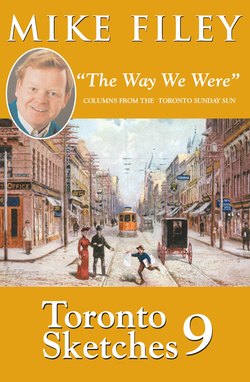Читать книгу Toronto Sketches 9 - Mike Filey - Страница 11
ОглавлениеCar Show on the Road Again
The Canadian International Car Show is one of Canada’s most popular consumer exhibitions. It usually takes place at the Toronto Convention Centre on Front Street West, where at least 300,000 visitors are wowed, dazzled, and amazed by the hundreds of cars, trucks, and specialty vehicles on display.
Newspaper records seem to be unanimous in the conclusion that the first gasoline-powered “horseless carriages” seen on Toronto’s frequently dusty, often muddy streets were those driven by anonymous American visitors who crossed the rather porous border on exploration trips into what many of them still referred to simply as British North America.
Incidentally, the term gasoline-powered is important in this story since once the visitors got here they would probably have seen a local patent attorney, one Frederick Fetherstonhaugh, roaming the city streets in a “battery-powered” machine built for him in the small Yonge Street factory of inventor William Still. By the way, that vehicle, the battery of which was recharged using power from the overhead of the Toronto and York Radial Railway that ran in front of Mr. Fetherstonhaugh’s place on Lake Shore Road near today’s Royal York Road, was still in service more than a decade later.
As for the first Canadian to own a gas-powered auto, there’s little doubt that the honour belongs to Hamilton, Ontario’s John Moodie. He purchased an American-built one-cylinder Winton on April 2, 1898, from none other than Alexander Winton, the company president who travelled to the Steel City from his Cleveland plant to conclude the deal in person. It’s been suggested that had Moodie made his acquisition one day sooner he would have been the purchaser of the first gas-powered car on the continent.
An awesome array of new vehicles awaits the crowds that will visit the 1929 edition of the National Motor Show of Canada held on the two floors of Simpson’s Arcadian Court in downtown Toronto.
Nevertheless, Moodie’s new car had cost him $1,000, but as usual there was still the duty to be paid. The customs people classified the strange vehicle as a “carriage” on which the duty was 35 percent. Moodie insisted that the car should be regarded as a “locomotive.” Moodie eventually won his case (the last in history to do so) thereby saving himself 100 bucks. Moodie didn’t keep the car very long, selling it to Torontonian Dr. Perry Doolittle, who then claimed the distinction of being the purchaser of Canada’s first used car.
Doolittle, who is buried in Toronto’s Mount Pleasant Cemetery, is an interesting person in his own right. He became a major player in the development of both cars and highways throughout the Dominion and was one of the founders of what we know today as the Canadian Automobile Association. He was also the first person (with friend Edward Flickenger) to drive a vehicle (a 1926 Model T Ford) from coast to coast under its own power, although for part of the trip flanged steel wheels replaced the car’s rubber tires to allow the vehicle to travel over railway tracks through otherwise inaccessible areas.
As the years went by, an ever-increasing number of vehicles from a wide variety of manufacturers began to appear on city streets, and it wasn’t long before impromptu “car shows” erupted on the side of the road as curious crowds gathered around the latest models. Every so often, local automobile dealers filled their showrooms with different models they had the rights to sell and then advertised the event as a “car show.” However, the first time that an “all-models” event was held, not just in Toronto but anywhere in the entire country, occurred on March 31, 1906, when the Canadian Automobile and Boat Show opened in the covered rink in the rear of the old Granite Club on Church Street (a portion of which still stands as 519 Church Street).
Other Toronto venues for automobile shows over the ensuing years were the Armouries on University Avenue (now the site of the Court House) and the Transportation (destroyed by fire in 1974) and Horticultural (still standing) buildings at the Canadian National Exhibition. So important were these shows that in 1929 a building dedicated specifically to cars and trucks was built at the east end of the CNE grounds. It was here that the newest models were first seen by the Canadian public attending the fall fair. Unfortunately, when the CNE decided to move its show dates from early September to late August, the only vehicles available for display were the previous year’s models. As this was of little use to the dealers or of interest to the public, the last of the once extremely popular CNE car shows was held in 1967.
One of the most unusual venues ever selected for a car show in Toronto was the one chosen for the February 1929 edition of the National Motor Show of Canada. Its exhibition hall was none other than Simpson’s magnificent two-storey Arcadian Court on the eighth and ninth floors of the store’s recently completed Bay Street addition. To get the cars into place, they had to be hoisted up the Richmond Street side of the building and hauled in through the windows. No doubt quite a sight. After the car show, the Arcadian Court would be advertised as the largest restaurant in a department store anywhere in the world.
February 9, 2003
